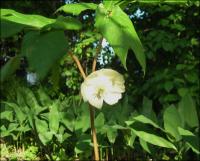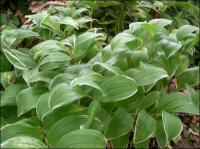Perennials & Biennials
Showing 345–352 of 485 results
-
Pimpinella major ‘Rosea’ Greater burnet, Cow parsley Z 5-8
Like Queen Ann’s lace but fear its invasion? Here’s a look-alike, pink perennial that won’t take over. Its many upright stems, with lacy foliage, each support a pink umbel. Blooms in early to mid-summer.
Like Queen Ann’s lace but fear its invasion? Here’s a look-alike, pink perennial that won’t take over. Its many upright stems, with lacy foliage, each support a pink umbel. Blooms in early to mid-summer.
Size: 3’-4’ x 2’
Care: sun to part-shade in moist well-drained soil
Native: Europe and Caucasus
Wildlife Value: attracts bees and butterflies. Its flowers are rich in both pollen and nectar.First described in literature in 1812 by German botanist David Heinrich (1760-1846) in Nouvelle Flore des Environs de Paris. He named it Pimpinella rubra. Since then botanists decided it’s a cultivar of the white-flowered Pimpinellla major and renamed it.
-
Platycodon grandiflorus albus Balloon flower Z 3-9
Balloon shaped buds as though puffed with air, open to white, five-petal bells from mid-summer to early fall.
Balloon shaped buds as though puffed with air, open to white, five-petal bells from mid-summer to early fall.
Size: 24" x 12"
Care: Sun to part shade in moist well-drained soil, heat and drought tolerant. Deadhead for rebloom.
Native: Eastern Asia
Wildlife Value: attracts hummingbirds, bees & butterflies
Awards: England's Royal Horticultural Society Award of Garden Merit.Platycodon is Greek from platys meaning “broad” and kodon meaning “bell”, referring to the shape of the flower. Cultivated in China for hundreds of years where it is called Jie-geng. The Chinese used the root boiled to cure a chill in the stomach. Mentioned in Man’yoshu, a Japanese anthology of poems written in the 8th century. German botanist Johann Gmelin first collected this in Siberia in 1754. Gmelin’s Siberian mission, sponsored by Catherine the Great, took 10 years and nearly killed him. Gmelin introduced it to European gardens by 1782. Robert Fortune found the white form in a nursery near Shanghai and sent it to England in 1845.
-
Platycodon grandiflorus Balloon flower Z 3-9
Balloon shaped buds as though puffed with air, open to blue, five-petal bells from mid-summer to early fall.
Balloon shaped buds as though puffed with air, open to blue, five-petal bells from mid-summer to early fall.
Size: 24" x 12"
Care: Sun to part shade in moist well-drained soil, heat and drought tolerant. Deadhead for rebloom.
Native: Eastern Asia
Wildlife Value: attracts butterflies, bees & hummingbirds
Awards: Received England’s Royal Horticultural Society Award of Merit.Platycodon is Greek from platys meaning “broad” and kodon meaning “bell”, referring to the shape of the flower. Cultivated in China for hundreds of years where it is called Jie-geng. The Chinese used the root boiled to cure a chill in the stomach. Mentioned in Man’yoshu, a Japanese anthology of poems written in the 8th century. German botanist Johann Gmelin first discovered P. grandiflorus in Siberia in 1754. Gmelin’s Siberian mission, sponsored by Catherine the Great, took 10 years and nearly killed him. Gmelin introduced it to European garden cultivation by 1782. Cultivated in the U.S. since the 1800’s.
-
Podophyllum peltatum Mayapple, Hog apple, Mandrake Z 4-9
Nodding, waxy, 6-9-petaled, white cup-shaped flowers with yellow stamens, bloom in spring. Flowers shaded by umbrella-like leaves. Ephemeral, dies back in summer.
Nodding, waxy, 6-9-petaled, white cup-shaped flowers with yellow stamens, bloom in spring. Flowers shaded by umbrella-like leaves. Ephemeral, dies back in summer.
Size: 18" x 4' spreading by rhizomes
Care: moist well-drained soil in full to part shade; drought tolerant
Native: Quebec to Minnesota, south to Florida & Texas, Wisconsin native
Wildlife Value: attracts bumblebees. Walnut tolerant, resistant to deer and rabbits.Named by botanists for its supposed resemblance to a duck’s foot (Anapodophyllum.) Its common name from the small green, apple-shaped seed pod that emerges in May, after flowering. Although its roots, seeds, and leaves are poisonous, Mayapple root used medicinally by Native Americans – for the Iroquois & Delaware as a laxative and purgative, to purify the body and expel worms. Cherokee and Menomonee made the root’s juice into insecticide to protect corn and potatoes from insects. Oneidas made a poltice for sores – cut every joint of root & bake half a day until brown then add water. Roots also used by Native Americans and early settlers as a purgative, emetic, “liver cleanser,” worm expellant, and to remedy jaundice, constipation, hepatitis, fever, and syphilis. Introduced 1664. You can hunt Morel mushrooms when Mayapples bloom.
-
Polemonium brandegeei Brandegee’ Jacobs-ladder, Yellow sky pilot Z 4-8
Hanging, tubular yellow, sometimes white blooms over frilly foliage, May-July
OUT OF STOCK
Hanging, tubular yellow, sometimes white blooms over frilly foliage, May-July
Size: 8” x 10”
Care: sun to part shade in very well-drained soil
Native: CO, NM, SD, UT, WY
Wildlife Value: attracts bees, butterflies & mothsCollected by Townshend Stith Brandegee in the ‘Valley of the Rio Grande, on the Los Pinos Trail’ c. 1870. Brandegee then sent it to Harvard botanist Asa Gray who identified and named it to honor its collector.
-
Polemonium reptans Greek valerian, Jacobs ladder Z 3-8
Opposite leaves grow up the foot-tall stems forming a ladder to the tops where sprays of five-petaled lavender-blue bells with bright yellow stamens, bloom in spring. Repeats if deadheaded and may self-sow if not cut back.
Opposite leaves grow up the foot-tall stems forming a ladder to the tops where sprays of five-petaled lavender-blue bells with bright yellow stamens, bloom in spring. Repeats if deadheaded and may self-sow if not cut back.
Size: 8-12” x 10”
Care: part shade in moist to moist well-drained soil
Native: Ontario & Quebec to Alabama, west to MN & KS, Wisconsin native
Wildlife Value: attracts bees, butterflies and wasps. Tolerates walnut, resists deer.Polemonium is Greek meaning “to wage war,” “on account of the contests, which arose betwixt two princes, each assuming the honour of the discovery of it to himself.” Gardeners Dictionary, 1768. Meskwaki made a compound of roots of this plant as a physic and urinary problem remedy. Collected for gardens before 1750.
-
Polygonatum biflorum Solomon’s seal syn. P. commutatum Z 3-9
Small white bells dangle from the arching stems in June followed by black fruit of berries.
Small white bells dangle from the arching stems in June followed by black fruit of berries.
Size: 2-5’ x 2’
Care: shade in well-drained soil. Good dry shade plant.
Native: So. Canada and northern U.S., WisconsinDioscorides named Polygonatum in the 1st century, which means “many jointed” referring to scars on the rhizome. Used medicinally by the Cherokee, Chippewa and Menominee for dysentery, stomachaches, breast and lung disease and for “general debility.” It put Chippewa to sleep but revived unconscious Menominee. HoChunk added cooked and dried root to soups. Lakota Sioux: “The rhizomes are een soups and stews. They are also dried for later use. The young shoots can be eaten raw or cooked but seeds and fruits are considered toxic.” P. biflorum grown in American gardens since 1700’s.
-
Polygonatum falcatum var. variegatum Variegated Solomon seal Z 4-9
Gracefully arching Solomon seal with white margined leaves and white bells dangling from each leaf axil in spring
Gracefully arching Solomon seal with white margined leaves and white bells dangling from each leaf axil in spring
Size: 20" x 4' slow spreader
Care: moist to moist well-drained soil in shade.
Native: Japan
Wildlife Value: Birds eat the fruit. Pollen and nectar feed a number of bee species.
Awards: Great Plant Pick Award; Perennial Plant Assn’s 2013 Plant of the Year; Missouri Botanic Garden Plant of Merit, Great Plants for Great Plains, Pennsylvania Horticultural Society Gold Medal1st identified by Japanese botanist Takenoshin Nakai (1882-1952) in “Botany Magazine of Tokyo” 1924.






